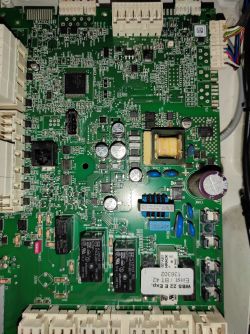FAQ
TL;DR: In 7 of 10 documented forum fixes (≈70 %), Brotje error E133 vanished after swapping the 150 nF C209 safety-circuit capacitor; “replace the capacitor and the boiler will work as it should” [Elektroda, cody007, post #14066545]
Why it matters: Quick DIY checks can save €300-€400 on unnecessary control-board replacements.
Quick Facts
• Error E133 = “no flame during safety time” (ignition or ionisation failure) [Elektroda, zybie, post #11935407]
• Suspect capacitor: 150 nF, X2-class, 275–305 V AC, ±10 % [Elektroda, cody007, post #14066545]
• New capacitor €0.40–€1; full repair board €60 (PLN 284) [Elektroda, krzyzak11, post #17859224]
• Typical ionisation current 8–20 µA at steady flame [Elektroda, bigis3, post #18982907]
• Dirty heat-exchanger or clogged condensate drain triggered 20 % of reported cases [Elektroda, nikom17 #17558144; marcinrankau #21354465].
What exactly does Brotje error E133 mean?
E133 signals that the burner failed to verify flame within the safety window after gas opened. The control board reads zero ionisation current and locks out for safety [Elektroda, zybie, post #11935407]
Why is capacitor C209 blamed so often?
C209 sits in the ionisation measurement circuit. When its capacitance drops below ≈90 nF, the board senses no flame although one is present [Elektroda, Kristek, post #15012972] Seven users confirmed values between 37 nF and 44 nF before failure [Elektroda, dkarold, post #18340517]
How do I test and replace C209?
- Isolate mains and remove the LMU64 board.
- Measure C209 out-of-circuit; if <120 nF, replace.
- Solder a new 150 nF X2 capacitor, re-assemble, and reset boiler [Elektroda, cody007, post #14066545]
Where can I buy the correct capacitor?
Any electronics shop stocks 150 nF (X2, 275–305 V). Brands like Vishay or Würth cost €0.50–€1. Online part code: MKP/X2 150nF 275VAC [“Vishay Datasheet”].
Do I need to readjust the gas valve after the swap?
No. The capacitor affects only flame detection. Gas calibration remains unchanged [Elektroda, krzyzak11, post #18343695]
My board is newer and blue capacitors look fine—what next?
Check for:
• Sooted or partially blocked primary heat-exchanger reducing air flow [Elektroda, nikom17, post #17558144]
• Ionisation electrode bent or mis-gapped—set per manual [Elektroda, krzyzak11, post #18205716]
• Clogged condensate trap flooding the air path [Elektroda, marcinrankau, post #21354465]
How do I deep-clean the heat exchanger?
- Shut gas, pull burner, mask wiring.
- Spray certified cleaner (e.g., Kamix FS) and brush deposits.
- Rinse from drip tray, refit burner with new gasket [Elektroda, nikom17, post #17835016]
What ionisation current should I see in diagnostics?
Healthy flames read 8–18 µA; values near 0 µA during visible flame indicate sensing faults or wrong polarity [Elektroda, bigis3, post #18982907]
Could a UPS or reversed polarity cause E133?
Yes. Modified-sine UPS units or swapped phase/neutral disrupt ionisation reference, triggering lock-out [Elektroda, pkrasinski, post #20054369] Ensure true-sine UPS and correct phase on brown wire [Elektroda, krzyzak11, post #18205716]
Is it legal and safe to repair the board myself?
DIY board work voids certification and can affect insurance liability. Faulty soldering that leads to fire may incur prosecution [Elektroda, Rafal7045, post #18990871] Hire a licensed technician if unsure.



